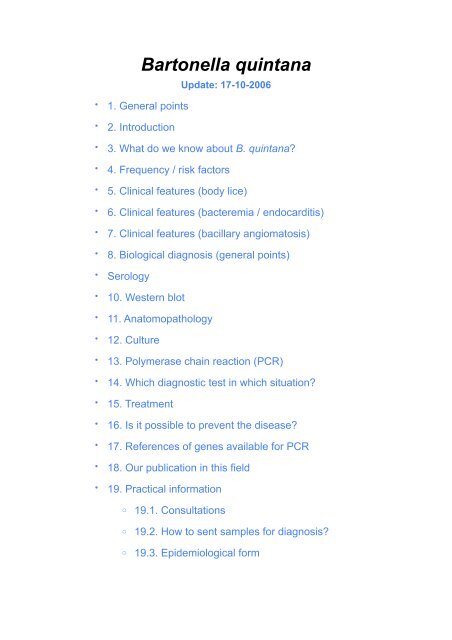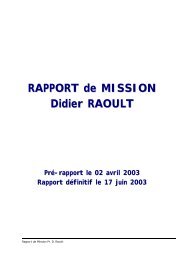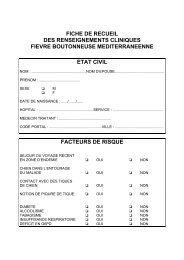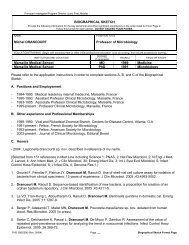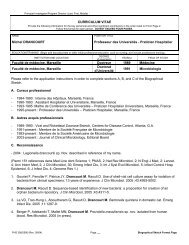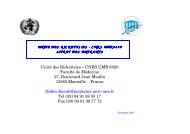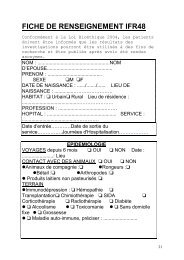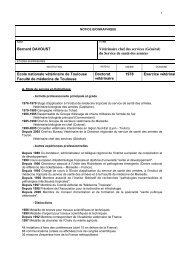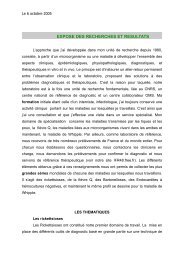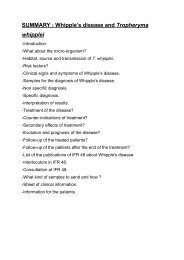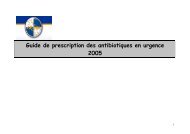Bartonella quintana
Bartonella quintana
Bartonella quintana
- No tags were found...
Create successful ePaper yourself
Turn your PDF publications into a flip-book with our unique Google optimized e-Paper software.
<strong>Bartonella</strong> <strong>quintana</strong>Update: 17-10-2006• 1. General points• 2. Introduction• 3. What do we know about B. <strong>quintana</strong>?• 4. Frequency / risk factors• 5. Clinical features (body lice)• 6. Clinical features (bacteremia / endocarditis)• 7. Clinical features (bacillary angiomatosis)• 8. Biological diagnosis (general points)• Serology• 10. Western blot• 11. Anatomopathology• 12. Culture• 13. Polymerase chain reaction (PCR)• 14. Which diagnostic test in which situation?• 15. Treatment• 16. Is it possible to prevent the disease?• 17. References of genes available for PCR• 18. Our publication in this field• 19. Practical informationooo19.1. Consultations19.2. How to sent samples for diagnosis?19.3. Epidemiological form
1. Genaral pointsThe genus <strong>Bartonella</strong> is composed of 21 species, includingB. bacilliformis, species previously classified in Rochalimaeaand Grahamella genus. The genus <strong>Bartonella</strong> belongs to thealpha proteaobacteria group, close to Brucella, Afipia,Agrobacterium and Rhizobium genus.<strong>Bartonella</strong> is considered as a facultative intracellularbacterium. In vivo, B. bacilliformis and B. <strong>quintana</strong> can beobserved in red blood cells in bacteriemic subjects. B.henselae, B. clarridgeiae, B. Koehlerae can be isolated anddetected in blood and red blood cells of bacteremic cats.Those bacteria also demonstrate a tropism for endothelialcells, which is correlated to their capacity to induceangioproliferatives lesions (verruga peruana for B.bacilliformis, and bacillary angiomatosis for B. henselae andB. <strong>quintana</strong>).2. IntroductionB. <strong>quintana</strong> was first described during World War I as theetiologic agent of trench fever, occurring among both alliedand German troops. This is considered as a reemergentpathogen in the homeless population. It is responsible forchronic asymptomatic bacteremias, endocarditis, andbacillary angiomatosis.References1. Kostrzewski J. The epidemiology of trench fever. Bull AcadPol Sci (Med) 1949;7:233-63.2. McNee JW, Renshaw A, Brunt EH. "Trench fever" : arelapsing fever occurring with the British forces in France. BrMed J 1916;12:225-34.3. Stein A, Raoult D. Return of trench fever. Lancet 1995;345:450-1.4. Brouqui P, Lascola B, Roux V, Raoult D. Chronic <strong>Bartonella</strong><strong>quintana</strong> bacteremia in homeless patients. N Engl J Med1999; 340:184-9.
References1. Maurin M, Raoult D. <strong>Bartonella</strong> (Rochalimaea) <strong>quintana</strong>infections. Clin Microbiol Rev 1996;9:273-92.2. Alsmark CM, Frank AC, Karlberg EO, Legault BA, Ardell DH,Canback B et al. The louse-borne human pathogen<strong>Bartonella</strong> <strong>quintana</strong> is a genomic derivative of the zoonoticagent <strong>Bartonella</strong> henselae. Proc.Natl.Acad.Sci.U.S.A 2004;101:9716-21.4. Frequency / risk factorsBody lice infestation is the condition allowing thetransmission of B. <strong>quintana</strong>. Cold weather, poverty, lack ofhygiene are risk factors for body louse infestation. B.<strong>quintana</strong> infection develops when those conditions aregathered, which is the case during wars, in refugee camps,and in the homeless population.The frequency of B. <strong>quintana</strong> infection in the generalpopulation is unknown. Many epidemiological studies havebeen performed in the homeless population. In Marseilles,France, a study performed among 930 homelessdemonstrated that 7.5% of them have previously been incontact with the bacterium (presence of antibodies), and that5.3% of them were bacteremic (presence of bacterium in
circulating blood). The transmission of B. <strong>quintana</strong> by thehuman body louse is probably not the only way. Thebacterium has been detected in cat flies, and in patients withchronic adenopathy, suggesting a transmission mode closeto the cat scratch disease.Références1. Raoult D, Ndihokubwayo JB, Tissot-Dupont H, et al. Outbreakof epidemic typhus associated with trench fever in Burundi.Lancet 1998; 352:353-8.2. Foucault C, Barrau K, Brouqui P, Raoult D. <strong>Bartonella</strong><strong>quintana</strong> bacteremia among homeless people. Clin Infect Dis2002; 35:684-9.3. Brouqui P, Stein A, Tissot-Dupont H, Gallian P, Badiaga S,Rolain JM, Mege JL, La Scola B, Berbis P, and Raoult D.Ectoparasitism and Vector-Borne Diseases in 930 HomelessPeople from Marseilles. Medicine (Baltimore) 2005;84(1):1-8.4. Rolain JM, Franc M, Davoust B, Raoult D. Moleculardetection of <strong>Bartonella</strong> <strong>quintana</strong>, B. koehlerae, B. henselae,B. clarridgeiae, Rickettsia felis, and Wolbachia pipientis in catfleas, France. Emerg.Infect.Dis. 2003; 9(3):338-42.5. Raoult D, Drancourt M, Carta A, Gastaut JA. <strong>Bartonella</strong>(Rochalimaea) <strong>quintana</strong> isolation in patient with chronicadenopathy, lymphopenia, and a cat. Lancet 1994; 343:977.5. Clinical features (body lice)B. <strong>quintana</strong> infection must be evoked in subjects infested byhuman body lice. Pediculosis is frequently denied and canthus not be searched be questioning the patient. Body licemust be searched in clothes (T-shirts, underwear, socks) andis the best way to diagnose pediculosis. The simplest way isto look for scratching lesions, typically retrieved in the neck,the thorax and the ankles.Picture 3 Body lice in clothes
chronic bacteremia, bacteria circulate in blood, and can beobserved in red blood cells. Chronic bacteremias are mostoften asymptomatic.Following this prolonged bacteremia, some subjects willdevelop endocarditis, i.e. infection of cardiac valves. Thereis however to date no evidence of the link betweenbacteremia and endocarditis. B. <strong>quintana</strong> endocarditis isresponsible for a mortality rate of up to 10%.Picture 5 B. <strong>quintana</strong> (in green), in red blood cells (confocalmicroscopy)Références1. McNee JW, Renshaw A, Brunt EH. "Trench fever" : arelapsing fever occurring with the British forces in France. BrMed J 1916; 12:225-34.2. Foucault C, Barrau K, Brouqui P, Raoult D. <strong>Bartonella</strong><strong>quintana</strong> bacteremia among homeless people. Clin Infect Dis2002; 35:684-9.3. Raoult D, Roux V. The body louse as a vector of reemerginghuman diseases. Clin Infect Dis 1999; 29:888-911.4. Foucault C, Rolain JM, Raoult D, Brouqui P. Detection of<strong>Bartonella</strong> <strong>quintana</strong> by direct immunofluorescenceexamination of blood smears of a patient with acute trenchfever. J Clin Microbiol 2004; 42:4904-6.5. Rolain JM, Foucault C, Guieu R, La Scola B, Brouqui P,Raoult D. <strong>Bartonella</strong> <strong>quintana</strong> in human erythrocytes. Lancet2002; 360:226-8.
6. Fournier PE, Lelievre H, Eykyn SJ, et al. Epidemiologic andclinical characteristics of <strong>Bartonella</strong> <strong>quintana</strong> and <strong>Bartonella</strong>henselae endocarditis: a study of 48 patients. Medicine(Baltimore) 2001; 80:245-51.7. Clinical features (bacillaryangiomatosis)Bacillary angiomatosis is proliferative vascular diseaseoccurring preferentially in immunocompromised subjects,mostly during HIV infection. Etiologic agents of bacillaryangiomatosis are B. <strong>quintana</strong> and B. henselae. Variousorgans may be involved, including the skin, the liver, thespleen, the bone marrow and lymph nodes. Cutaneouslesions of bacillary angiomatosis may be unique or multiple,superficial or deep. Superficial lesions may be red, purple, oruncolored. Deep lesions are often uncolored. Oral, anal,intestinal mucosa, as conjunctive may be involved. Theprincipal differential diagnosis of bacillary angiomatosis isKaposi sarcoma.B. <strong>quintana</strong> is responsible for sub-cutaneous lesions, bonelesions, and liver lesions (hepatic peliosis) as lymph nodeinvolvement is more typical of B. henselae.Picture 6 cutaneous lesions of bacillary angiomatosis
References1. Koehler JE, Sanchez MA, Garrido CS, Whitfeld MJ, ChenFM, Berger TG et al. Molecular epidemiology of bartonellainfections in patients with bacillary angiomatosis-peliosis.N.Engl.J Med 1997; 337:1876-83.2. Gasquet, S., M. Maurin, P. Brouqui, H. Lepidi, and D. Raoult.1998. Bacillary angiomatosis in immunocompromisedpatients: a clinicopathological and microbiological study ofseven cases and review of literature. AIDS 12:1793-18038. Biological diagnosis – general pointsThe diagnosis is often difficult. Several diagnostic methodsare often necessary regarding the patient status and theclinical signs. Non specific diagnosis of the disease mustinclude a blood cell count, and transaminase. The specificdiagnosis relies on direct diagnosis (blood cultures,
cultures of skin biopsies, cardiac valves, or direct evidence ofthe presence of the bacterium by immunohistochemistryusing a specific monoclonal antibody, performed onhistological samples or in blood smears (detection in redblood cells). Genome amplification by PCR is also possible.The specific diagnosis also relies on indirect diagnosis(serology, western blot and cross adsorption).9. SerologyThe sensibility of serology varies regarding the technic used.The positive predictive value is about 65%. The cutoffvalue of antibody titers varies regarding the technique used.Serology is particularly usefull during B. <strong>quintana</strong> bacteremiaand during <strong>Bartonella</strong> sp. endocarditis. We consider, in ourlaboratory, an IgG titer of more than 1:100 significant duringbacteremia, and an IgG titer of more than 1:800 highlycorrelated with the presence of an endocarditis. Duringendocarditis, patients exhibit antibodies against all <strong>Bartonella</strong>species, while patients with chronic bacteremia withoutendocarditis only develop antibodies against B. <strong>quintana</strong>.Serological diagnosis however has its own limits. Antibodytiters vary regarding antigen preparation technique. Bacterialantigens prepared grown onto eukaryote cell cultures yieldhigher antibody titers than those grown in axenic media.Another point is that some patients infected by <strong>Bartonella</strong> sp.do not demonstrate detectable specific antibodies. This is thecase for immunocompromised patients, which is a limit forthe diagnosis of bacillary angiomatosis. Serological tests alsolack specificity. Cross reactions between the different speciesof <strong>Bartonella</strong> have been demonstrated, as between<strong>Bartonella</strong> sp. and Chlamydia and Coxiella burnetii.Picture 7 Positive indirect immunofluorescence for B.henselae in a patient with cat scratch disease.
References1. Maurin, M., F. Eb, J. Etienne, and D. Raoult. 1997.Serological cross-reactions between <strong>Bartonella</strong> andChlamydia species: Implications for diagnosis.J.Clin.Microbiol. 35:2283-2287.2. Maurin, M., J. M. Rolain, and D. Raoult. 2002. Comparison ofin-house and commercial slides for detection ofimmunoglobulins G and M by immunofluorescence againstB a r t o n e l l a h e n s e l a e a n d B a r t o n e l l a<strong>quintana</strong>.Clin.Diag.Lab.Immunol. 9:1004-1009.3. Rolain, J. M., C. Lecam, and D. Raoult. 2003. Simplifiedserological diagnosis of endocarditis due to Coxiella burnetiiand <strong>Bartonella</strong>. Clin.Diag.Lab.Immunol. 10:1147-1148.10. Western blotWestern blot and cross adsorption allows to diagnose<strong>Bartonella</strong> sp. endocarditis and to identify the speciesinvolved.Picture 7 Example : B. <strong>quintana</strong> endocarditis (afteradsorption with B. <strong>quintana</strong> antigen, all antibodies areremoved)
Method: for <strong>Bartonella</strong> endocarditis, two or more antigen areused. Antigens correspond to the suspected etiologies. Forcross adsorption, 3 samples of the patient’s serum are tested(dilution 1:200) before and after reaction with antigen A andB. Western blot is then performed against antigen A and B.Non adsorbed serum displays antibodies against antigen Aand B. Adsorbed serum do not displays antibodies againstthe antigen it has been adsorbed with. If one adsorbedantigen removes both homologous and heterologousantibodies (for example, after adsorption with antigen A,antibodies against both antigen A and B disappear, whileafter adsorption with antigen B antibodies against antigen Apersist), then we can certify there is a specific reactioninduced by antigen A.Reference1. Houpikian, P. and D. Raoult. 2003. Western immunoblottingfor <strong>Bartonella</strong> endocarditis. Clin.Diagn.Lab Immunol.10:95-10211. Anatomopathology
Cutaneous lesions of bacillary angiomatosis arecharacterized by a lobular proliferation of capillaryvessels. Endothelial cells constitute the wall of neo vessels.Bacterial clusters can be visualized after Warthin starrystain, or more specifically by direct immunofluorescenceor immunohistochemistry. Histological aspect is similar tothat observed in verruga peruana lesions, but can be easilydifferentiated from Kaposi sarcoma lesions. Histologicalexam of cardiac valves during <strong>Bartonella</strong> endocarditisretrieves larges vegetations associated with a destruction ofunderlying valvular tissue. Numerous bacteria can bevisualized in the valvular tissue after Warthin starry stain orusing immunohistochemistryReferences1. Lepidi, H., P. E. Fournier, and D. Raoult. 2000. Quantitativeanalysis of valvular lesions during <strong>Bartonella</strong> endocarditis.Am J Clin Pathol 114:880-889.2. Min, K. W., J. A. Reed, and D. F. Welch. 1994.Morphologically variable bacilli of cat scratch disease areidentified by immunocytochemical labelling with antibodies toRochalimaea henselae. Am.J.Clin.Pathol. 101:607-610.3. Reed, J. A., D. J. Brigati, S. D. Flynn, N. S. Mcnutt, K. W. Min,D. F. Welch, and L. N. Slater. 1992. Immunocytochemicalidentification Rochalimaea henselae in bacillary (epithelioid)angiomatis, parenchymal bacillary peliosis, and persistentfever with bacteriema. Am.J.Surg.Pathol. 16:650-657Picture 8 Lésion cutanée au cours de l'angiomatosebacillaire
Picture 9 <strong>Bartonella</strong> endocarditis: Warthin-Starry stainPicture 10 <strong>Bartonella</strong> endocarditis: Immunohistochimie
12. CultureBacteria of the genus <strong>Bartonella</strong> can be isolated from bloodand tissues (lymph nodes, bone, liver, skin, bone marrow,cardiac valves). It can be grown both in cell culture andaxenic media. Culture in axenic media must used fresh bloodenriched media in humid atmosphere with 5% CO2. Optimaltemperature is 37°C. Cell culture can be performed ontoL929, HeLA and endothelial cells. A combination of the twomethods seems to be necessary to obtain good results.Picture 11 B. henselae culture in blood agar.Picture 12 Gimenez stainRéférences1. La Scola, B. and D. Raoult. 1999. Culture of <strong>Bartonella</strong><strong>quintana</strong> and <strong>Bartonella</strong> henselae from human samples: a 5-year experience (1993 to 1998). J.Clin.Microbiol.37:1899-1905
13. Polymerase chain reaction (PCR)Direct amplification by PCR from various samples is themore specific method for the diagnosis of <strong>Bartonella</strong>infection, particularly for the diagnosis of endocarditis fromblood and cardiac valves.This method is invasive and necessitates tissue biopsies.Various genes have been used (see appendix: list andreferences of genes). In our laboratory, which is the nationalreference center, with perform amplification using threespecific genes: pap31, groEl and ITS. We use a real timequantitative PCR. The specificity of obtained fragments issystematically verified by sequencing or by hybridationFigure 1 Sequencing of PCR product using ITS geneReferences1. Roux, V. and D. Raoult. 1995. Inter-and intraspeciesidentification of <strong>Bartonella</strong> (Rochalimea) species.J.Clin.Microbiol. 33:1573-1579.2. Zeaiter, Z., P. E. Fournier, G. Greub, and D. Raoult. 2003.Diagnosis of <strong>Bartonella</strong> endocarditis by a real-time nestedPCR assay using serum. J.Clin.Microbiol. 41:919-925.3. Zeaiter, Z., P. E. Fournier, H. Ogata, and D. Raoult. 2002.Phylogenetic classification of <strong>Bartonella</strong> species bycomparing groEL sequences. Int.J.Syst.Evol.Microbiol.52:165-171.4. Zeaiter, Z., P. E. Fournier, and D. Raoult. 2002. Genomicvariation of <strong>Bartonella</strong> henselae strains detected in lymph
nodes of patients with cat scratch disease. J.Clin.Microbiol.40:1023-1030.5. Fenollar, F. and D. Raoult. 2004. Molecular genetic methodsfor the diagnosis of fastidious microorganisms. APMIS112:785-80714. Which diagnostic test in whichsituation ?Histology Serology Culture PCREndocarditis ++ +++ ++ +++Bacillary angiomatosis +++ - + ++Isolated bacteremia - + ++ -15. TreatmentThe treatment of B. <strong>quintana</strong> chronic bacteremias is ofinterest because it could prevent the occurrence of theendocarditis. The recommended treatment is as follows:• Doxycycline : 200 mg/day in one oral daily dose, for 28 days,in combination with• Gentamicin : 3 mg/Kg of body weight/day in one intravenousdaily dose, for 14 daysRecommended treatment of endocarditis is as follows:• Doxycycline : 100 mg bid orally for 6 weeks, in combinationwith• Gentamicin : 3 mg/Kg of body weight/day in one intravenousdaily dose, for 14 days
The best treatment for bacillary angiomatosis iserythromycin. The recommended treatment is as follows:• Erythromycin : 500 mg qid orally, for 3 monthes.Doxycycline is photosensitive and can be responsible burnafter exposition to the sun. Gentamicin is nephrotoxic, i.e.toxic for the kidneys and ototoxic, i.e. toxic for the audition.Erythromycin can be responsible for digestive disorders andmore rarely for allergic manifestations and medicamentoushepatitis.References1. Foucault C, Raoult D, Brouqui P. Randomized open trial ofgentamicin and doxycycline for eradication of <strong>Bartonella</strong><strong>quintana</strong> from blood in patients with chronic bacteremia.Antimicrob Agents Chemother 2003; 47:2204-7.2. Rolain JM, Brouqui P, Koehler JE, Maguina C, Dolan MJ,Raoult D. Recommendations for treatment of humaninfections caused by <strong>Bartonella</strong> species. Antimicrob AgentsChemother 2004; 48:1921-33.3. Raoult D, Fournier PE, Vandenesch F, et al. Outcome andtreatment of <strong>Bartonella</strong> endocarditis. Arch Intern Med 2003;163:226-30.Tableau 1. Therapeutic recommendations for the treatmentof B. <strong>quintana</strong> infectionsDisease Adults Children ReferenceTrench fever and Doxycycline 200 mg/d for 4Chronic weeks and Gentamicin 3 unknown 1 et 2bacteremias mg/kg/d for 2 weeksErythromycin 2A n g i o m a t o s e Erythromycine 2 g/d for 3g / d f o r 3bacillaire monthsmonths3Erythromycin 2Erythromycin 2 g/d for 4Hepatic peliosis g / d f o r 4monthsmonths3
EndocarditisGentamicin 3 mg/kg/d for 3weeks and amoxicillin 12 g/unknown 4d for 6 weeks or doxycyclin200 mg/d for 6 weeksReferences1. Bass, J. W., J. M. Vincent, and D. A. Person. 1997. Theexpanding spectrum of <strong>Bartonella</strong> infections: I. Bartonellosisand trench fever. Pediat.Inf.Dis.J. 16:2-10.2. Foucault, C., D. Raoult, and P. Brouqui. 2003. Randomizedopen trial of gentamicin and doxycycline for eradication of<strong>Bartonella</strong> <strong>quintana</strong> from blood in patients with chronicbacteremia. Antimicrob.Agents Chemother. 47:2204-2207.3. Koehler, J. E. and J. W. Tappero. 1993. Bacillaryangiomatosis and bacillary peliosis in patients infected withhuman immunodeficiency virus. Clin.Infect.Dis. 17 :612-624.4. Raoult, D., P. E. Fournier, F. Vandenesch, J. L. Mainardi, S. J.Eykyn, J. Nash, E. James, C. Benoit-Lemercier, and T. J.Marrie. 2003. Outcome and treatment of bartonellaendocarditis. Arch.Intern.Med. 163:226-230.5. Rolain, J. M., P. Brouqui, J. E. Koehler, C. Maguina, M. J.Dolan, and D. Raoult. 2004. Recommendations for treatmentof human infections caused by <strong>Bartonella</strong> species.Antimicrob.Agents Chemother. 48:1921-1933.16. Is it possible to prevent thedisease ?The prevention of B. <strong>quintana</strong> infections in the homelesspopulation relies on the eradication of body lice infestation.Treatment of human body lice infestation, also calledPediculosis relies on the complete change of all wornclothes, or on the use of insecticides such as DDT. Thosesmethods do not prevent reinfestations in situation whenpromiscuity is prevalent, such as in homeless shelters.
References1. Raoult D, Roux V. The body louse as a vector of reemerginghuman diseases. Clin Infect Dis 1999; 29:888-911.17. References of genes available forPCRTable 3 List of sequences available for <strong>Bartonella</strong> sp.Amplification.MicroorganiReGene primer SequencesmfB .ribCclarridgeiaeF PBC5 TACATAACGAGCCAATT 2B .ribCclarridgeiaeRPBC15 TAGCTTTAGAACAATATGGT 2B. henselae ribC F PBH-L1 GATATCGGTTGTGTTGAAGA 2B. henselae ribC RPBH-R1 AATAAAAGGTATAAAACGCT 2B .ribCbacilliformisF PBH-L1 GATATCGGTTGTGTTGAAGA 2B .ribCbacilliformisRPBB-R1 AAAGGCGCTAACTGTTC 2B. <strong>quintana</strong> ribC F PBH-L1 GATATCGGTTGTGTTGAAGA 2B. <strong>quintana</strong> ribC RPBQ-R1 AAAGGGCGTGAATTTTG 2All <strong>Bartonella</strong> ribC F PBH3 CCAAGTGCTACATAACCATC 2All <strong>Bartonella</strong> ribC RPBH4 CGGGTTGTTATTGCTCTTAC 216s-2All (except B. 3 sF 16SFbacilliformis) spaceAGAGGCAGGCAACCACGGTA 3r16s-2All (except B. 3 sR23S1bacilliformis) spaceGCCAAGGCATCCACC 3r
16s-23 sAll <strong>Bartonella</strong> F QHVE1spaceTTCAGATGATGATCCCAA 3r16s-23 sAll <strong>Bartonella</strong> RQHVE2spaceTTGGGATCATCATCTGAA 3r16s-23 sAll <strong>Bartonella</strong> F QHVE3spaceGATATATTCAGACATGTT 3r16s-23 sAll <strong>Bartonella</strong> RQHVE4spaceAACATGTCTGAATATATC 3r16s-2B . 3 sF BABFbacilliformis spaceCTGGATCACCTCCTTTCTAA 3r16s-2B . 3 sRBABRbacilliformis spaceATGCCCTTAAGACACTTGAT 3r16s-2B. <strong>quintana</strong>3 sF BQFspaceCTCCACCATTTTAGGTCATC 3rB. <strong>quintana</strong>16s-23 sRBQRspaceGGTTTTGAGAATTCCCTTGC 3r16s-23 sAll <strong>Bartonella</strong> F 16s1space(C/T)CTTCGTTTCTCTTTCTTCA 4r16s-23 sAll <strong>Bartonella</strong> R16s2spaceGGATAAACCGGAAAACCTTC 4r
16s-23 sAll <strong>Bartonella</strong> F 16s3space(C/T)CTTCGTTTCTCTTTCTTCA 4r16s-23 sAll <strong>Bartonella</strong> R16s4spaceAACCAACTGAGCTACAAGCC 4r16s-23 sAll <strong>Bartonella</strong> F 16s5spaceCTCTTTCTTCAGATGATGATCC 4r16s-23 sAll <strong>Bartonella</strong> R16s6spaceAACCAACTGAGCTACAAGCCCT 4rAll <strong>Bartonella</strong> ribC F BARTON- TAACCGATATTGGTTGTGTTGAAG 61FAll <strong>Bartonella</strong> ribC R BARTON- TAAAGCTAGAAAGTCTGGCAACAT62R AACGAll <strong>Bartonella</strong> 16s Sprobe ATTTGGTTGGGCACTCTAGGGG 7All <strong>Bartonella</strong> 16s Rp2a ACGGCTACCTTGTTAGGACTT 8All <strong>Bartonella</strong> 16s F 357f TACGGGAGGCAGCAG 8All <strong>Bartonella</strong> 16s R357ra CTGCTGCCTCCCGTA 8All <strong>Bartonella</strong> 16s F 536F CAGCAGCCGCGGTAATAC 8All <strong>Bartonella</strong> 16s R536R GTATTACCGCGGCTGCTG 8All <strong>Bartonella</strong> 16s F 800F ATTAGATACCCTGGTAG 8All <strong>Bartonella</strong> 16s R800R CTACCAGGGTATCTAAT 8All <strong>Bartonella</strong> 16s F 1050F TGTCGTCAGCTCGTG 8All <strong>Bartonella</strong> 16s R1050R CACGAGCTGACGACA 8All <strong>Bartonella</strong> 35KD F 35KD1fa GTCGCTAAAGGCTGATGA 8All <strong>Bartonella</strong> 35KD R35KD2ra GACTGATATCGTGCGTGTG 8All <strong>Bartonella</strong> 35KD F 35KDs1f GGTACGACGACAGTAATTGTT 8All <strong>Bartonella</strong> 35KD R35KDs2r GATTTAAGAGATACCAACCA 8All <strong>Bartonella</strong> PAP F PAP1fa CTTTAATGACGACTTCTGTT 8All <strong>Bartonella</strong> PAP RPAP4ra CCGAAATCTGAGTAACGGTA 8All <strong>Bartonella</strong> PAP RPAP2r CCCTAAATGTTTCAAGTTCA 8All <strong>Bartonella</strong> PAP F PAP3f GCTGACAGAGAAGACGCAA 8
All <strong>Bartonella</strong> groELF BbHs233. CGTGAAGTTGCCTCAAAAACCp9All <strong>Bartonella</strong> groELR BbHs1630 AATCCATTCCGCCCATTC.n9All <strong>Bartonella</strong> rpoB F QVE1 TTCAGATGATGATCCCAAGC 10All <strong>Bartonella</strong> rpoB RQVE3 AACATGTCTGAATATATCTTC 10All <strong>Bartonella</strong> Bfp1 ATTAATCTGCAYCGGCCAGA 14All <strong>Bartonella</strong> Bfp2 ACVGADACACGAATAACACC 14All <strong>Bartonella</strong> Bfs3 TTACAAAAATCYGTTGATAC 14All <strong>Bartonella</strong> Bfs4 GTATCAACRGATTTTTGTAA 14All <strong>Bartonella</strong> ftsZ F BaftsZF GCTAATCGTATTCGCGAAGAA 14All <strong>Bartonella</strong> ftsZ RBaftsZR GCTGGTATTTCCAAYTGATCT 14B. henselae,B h f t s ZB . ftsZGCGAACTACGGCTTACTTGC1393.nclarridgeiae14B. henselae,B . ftsZclarridgeiaeBh ftsZCGGTTGGAGAGCAGTTTCGTC 141247.pB. <strong>quintana</strong> ftsZ F B q GCACATATTCTTGATGAGATftsZseqF14B. <strong>quintana</strong> ftsZ R B q CCCCTATCATCTCATCAAGftsZseqR14B .bacilliformis ftsZ F B b GCGCATGTTCTTAGTGAAATftsZseqF14B .bftsZ RB CCTGTATACGTGATGCATTTbacilliformis ftsZseqR14All <strong>Bartonella</strong> ftsZ FTS1p GCCTTCTCATCCTCAACTT 14A l l / /ftsZ<strong>Bartonella</strong>/FTS2p CAGCCTCTTCACGATGTG 14All <strong>Bartonella</strong> p a p 31All <strong>Bartonella</strong> p a p 31PAPn1 TTCTAGGAGTTGAAACCGAT 15PAPn2 GAAACACCACCAGCAACATA 15All <strong>Bartonella</strong> p a p 31PAPns2 GCACCAGACCATTTTTCCTT 15All <strong>Bartonella</strong> p a p 31PAPns1 CAGAGAAGACGCAAAAACCT 15All <strong>Bartonella</strong> groEL HSPps1 CAGAAGTTGAAGTGAAAGAAAA 15All <strong>Bartonella</strong> groEL HSPps2 GCNGCTTCTTCACCNGCATT 15All <strong>Bartonella</strong> groEL HSPps4 GCTGGNGGTGTTGCNGTTA 15
All <strong>Bartonella</strong> groEL HSPps3 GCTGTNGAAGANGGNATTGT 15References1. Anderson, B. E. and M. A. Neuman. 1997. <strong>Bartonella</strong> spp. asemerging human pathogens. Clin.Microbiol.Rev. 10:203-219.2. Bereswill, S., S. Hinkelmann, M. Kist, and A. Sander. 1999.Molecular analysis of riboflavin synthesis genes in <strong>Bartonella</strong>henselae and use of the ribC gene for differentiation of<strong>Bartonella</strong> species by PCR. J.Clin.Microbiol. 37:3159-3166.3. Houpikian, P. and D. Raoult. 2001. 16S/23S rRNA IntergenicSpacer Regions for Phylogenetic Analysis, Identification, andSubtyping of <strong>Bartonella</strong> Species. J.Clin.Microbiol.39:2768-2778.4. Jensen, W. A., M. Z. Fall, J. Rooney, D. L. Kordick, and E. B.Breitschwerdt. 2000. Rapid identification and differentiation of<strong>Bartonella</strong> species using a single-step PCR assay.J.Clin.Microbiol. 38:1717-1722.5. Joblet, C., V. Roux, M. Drancourt, J. Gouvernet, and D.Raoult. 1995. Identification of <strong>Bartonella</strong> (Rochalimaea)species among fastidious Gram-negative bacteria based onthe partial sequence of the citrate-synthase gene.J.Clin.Microbiol. 33:1879-1883.6. Johnson, G., M. Ayers, S. C. McClure, S. E. Richardson, andR. Tellier. 2003. Detection and identification of <strong>Bartonella</strong>species pathogenic for humans by PCR amplificationtargeting the riboflavin synthase gene (ribC). J.Clin.Microbiol.41:1069-1072.7. Kerkhoff, F. T., A. M. C. Bergmans, A. van der Zee, and A.Rothova. 1999. Demonstration of <strong>Bartonella</strong> grahamii DNA inocular fluids of a patient with neuroretinitis. J.Clin.Microbiol.37:4034-4038.8. La Scola, B., Z. Liang, Z. Zeaiter, P. Houpikian, P. A. D.Grimont, and D. Raoult. 2002. Genotypic characteristics of
two serotypes of <strong>Bartonella</strong> henselae. Journal of ClinicalMicrobiology 40 :2002-2008.9. Marston, E. L., J. W. Sumner, and R. L. Regnery. 1999.Evaluation of intraspecies genetic variation within the 60 kDaheat-shock protein gene (groEL) of <strong>Bartonella</strong> species. Int JSyst Bacteriol 49:1015-1023.10.Patel, R., J. O. Newell, G. W. Procop, and D. H. Persing.1999. Use of polymerase chain reaction for citrate synthasegene to diagnose <strong>Bartonella</strong> <strong>quintana</strong> endocarditis. Am J ClinPathol 112:36-40.11.Renesto, P., J. Gouvernet, M. Drancourt, V. Roux, and D.Raoult. 2001. Use of rpoB gene analysis for detection andidentification of <strong>Bartonella</strong> species. J.Clin.Microbiol.39:430-437.12.Roux, V. and D. Raoult. 1995. The 16S-23S rRNA intergenicspacer region of <strong>Bartonella</strong> (Rochalimaea) species is longerthan usually described in other bacteria. Gene 156:107-111.13.Zeaiter, Z., P. E. Fournier, H. Ogata, and D. Raoult. 2002.Phylogenetic classification of <strong>Bartonella</strong> species bycomparing groEL sequences. Int.J.Syst.Evol.Microbiol.52:165-171.14.Zeaiter, Z., P. E. Fournier, and D. Raoult. 2002. Genomicvariation of <strong>Bartonella</strong> henselae strains detected in lymphnodes of patients with cat scratch disease. J.Clin.Microbiol.40:1023-1030.15.Zeaiter, Z., Z. Liang, and D. Raoult. 2002. Geneticclassification and differentiation of <strong>Bartonella</strong> species basedon comparison of partial ftsZ gene sequences.J.Clin.Microbiol. 40:3641-3647.18. Our publication in this field1. Benslimani A, Fenollar F, Raoult D. Bacterial zoonoses andinfective endocarditis, Algeria. Emerg Infect Dis. 2005 Feb;11(2):216-24.
2. Drancourt M, Tran-Hung L, Courtin J, Lumley H, Raoult D.<strong>Bartonella</strong> <strong>quintana</strong> in a 4000-year-old human tooth. J InfectDis. 2005 Feb 15;191(4):607-11. Epub 2005 Jan 10.3. Brouqui P, Stein A, Dupont HT, Gallian P, Badiaga S, RolainJM, Mege JL, LaScola B, Berbis P, Raoult D. Ectoparasitismand vector-borne diseases in 930 homeless people fromMarseilles. Medicine (Baltimore). 2005 Jan;84(1):61-8.4. Foucault C, La Scola B, Lindroos H, Andersson SG, RaoultD. Multispacer typing technique for sequence-based typing of<strong>Bartonella</strong> <strong>quintana</strong>. J Clin Microbiol. 2005 Jan;43(1):41-8.5. Aboudharam G, Fournier PE, Drancourt M, Raoult D,Foucault C, Brouqui P. Molecular detection of <strong>Bartonella</strong><strong>quintana</strong> DNA in the dental pulp of a homelesspatient. Eur JClin Microbiol Infect Dis. 2004 Dec;23(12):920-2.6. La Scola B, Raoult D. Acinetobacter baumannii in humanbody louse. Emerg Infect Dis. 2004 Sep;10(9):1671-3. PMID:154981757. Foucault C, Rolain JM, Raoult D, Brouqui P. Detection of<strong>Bartonella</strong> <strong>quintana</strong> by direct immunofluorescenceexamination of blood smears of a patient with acute trenchfever. J Clin Microbiol. 2004 Oct;42(10):4904-6.8. Schiellerup P, Dyhr T, Rolain JM, Christensen M, DamsgaardR, Ethelberg S,Fisker N, Frost Andersen N, Raoult D,Krogfelt KA. Low seroprevalence of bartonella species indanish elite orienteers. Scand J Infect Dis. 2004;36(8):604-6.9. Durupt F, Seve P, Roure C, Biron F, Raoult D, Broussolle C.Liver and spleen abscesses without endocarditis due to<strong>Bartonella</strong> <strong>quintana</strong> in an immunocompetent host. Eur J ClinMicrobiol Infect Dis. 2004 Oct;23(10):790-110.Levy PY, Corey R, Berger P, Habib G, Bonnet JL, Levy S,Messana T, DjianeP, Frances Y, Botta C, DeMicco P, DumonH, Mundler O, Chomel JJ, Raoult D. Etiologic diagnosis of204 pericardial effusions. Medicine (Baltimore). 2003 Nov;82(6):385-91.11.Levy PY, Fournier PE, Carta M, Raoult D. Pericardial effusionin a homeless man due to <strong>Bartonella</strong> <strong>quintana</strong>. J ClinMicrobiol. 2003 Nov;41(11):5291-3.
12.Rolain JM, Arnoux D, Parzy D, Sampol J, Raoult D.Experimental infection of human erythrocytes from alcoholicpatients with <strong>Bartonella</strong> <strong>quintana</strong>. Ann N Y Acad Sci. 2003Jun;990:605-11.13.Rolain JM, Foucault C, Brouqui P, Raoult D. Erythroblastcells as a target for <strong>Bartonella</strong> <strong>quintana</strong> in homeless people.Ann N Y Acad Sci. 2003 Jun;990:485-7. No abstractavailable.14.Foucault C, Raoult D, Brouqui P. Randomized open trial ofgentamicin and doxycycline for eradication of <strong>Bartonella</strong><strong>quintana</strong> from blood in patients with chronic bacteremia.Antimicrob Agents Chemother. 2003 Jul;47(7):2204-7.15.Bernit E, Veit V, La Scola B, Tissot-Dupont H, Gachon J,Raoult D, HarleJR. <strong>Bartonella</strong> <strong>quintana</strong> and Mycobacteriumtuberculosis coinfection in an HIV-infected patient withlymphadenitis. J Infect. 2003 May;46(4):244-6.16.Rolain JM, Franc M, Davoust B, Raoult D. Moleculardetection of <strong>Bartonella</strong> <strong>quintana</strong>, B. koehlerae, B. henselae,B. clarridgeiae, Rickettsia felis, and Wolbachia pipientis in catfleas, France. Emerg Infect Dis. 2003 Mar;9(3):338-42.17.Capo C, Amirayan-Chevillard N, Brouqui P, Raoult D, MegeJL. <strong>Bartonella</strong> <strong>quintana</strong> bacteremia and overproduction ofinterleukin-10: model of bacterial persistence in homelesspeople. J Infect Dis. 2003 Mar 1;187(5):837-44. Epub 2003Feb 24.18.Rolain JM, Maurin M, Mallet MN, Parzy D, Raoult D. Cultureand antibiotic susceptibility of <strong>Bartonella</strong> <strong>quintana</strong> in humanerythrocytes. Antimicrob Agents Chemother. 2003 Feb;47(2):614-9.19.Houpikian P, Raoult D. Western immunoblotting for<strong>Bartonella</strong> endocarditis. Clin Diagn Lab Immunol. 2003 Jan;10(1):95-102.20.Fournier PE, Ndihokubwayo JB, Guidran J, Kelly PJ, RaoultD. Human pathogens in body and head lice. Emerg InfectDis. 2002 Dec;8(12):1515-8. Review.21.Maurin M, Rolain JM, Raoult D. Comparison of in-house andcommercial slides for detection by immunofluorescence of
immunoglobulins G and M against <strong>Bartonella</strong> henselae and<strong>Bartonella</strong> <strong>quintana</strong>. Clin Diagn Lab Immunol. 2002 Sep;9(5):1004-9.22.Foucault C, Barrau K, Brouqui P, Raoult D. <strong>Bartonella</strong><strong>quintana</strong> Bacteremia among Homeless People. Clin InfectDis. 2002 Sep 15;35(6):684-9. Epub 2002 Aug 20.23.Rolain JM, Foucault C, Guieu R, La Scola B, Brouqui P,Raoult D. <strong>Bartonella</strong> <strong>quintana</strong> in human erythrocytes. Lancet.2002 Jul 20;360(9328):226-8.24.Fournier PE, Mainardi JL, Raoult D. Value ofmicroimmunofluorescence for diagnosis and follow-up of<strong>Bartonella</strong> endocarditis. Clin Diagn Lab Immunol. 2002 Jul;9(4):795-801.25.Raoult D, Foucault C, Brouqui P. Infections in the homeless.Lancet Infect Dis. 2001 Sep;1(2):77-84. Review.26.Zeaiter Z, Fournier PE, Ogata H, Raoult D. Phylogeneticclassification of <strong>Bartonella</strong> species by comparing groELsequences. Int J Syst Evol Microbiol. 2002 Jan;52(Pt 1):165-71.27.Jacomo V, Kelly PJ, Raoult D. Natural history of <strong>Bartonella</strong>infections (an exception to Koch's postulate). Clin Diagn LabImmunol. 2002 Jan;9(1):8-18.28.Fournier PE, Lelievre H, Eykyn SJ, Mainardi JL, Marrie TJ,Bruneel F, RoureC, Nash J, Clave D, James E, Benoit-Lemercier C, Deforges L, Tissot-Dupont H,Raoult D.Epidemiologic and clinical characteristics of <strong>Bartonella</strong><strong>quintana</strong> and <strong>Bartonella</strong> henselae endocarditis: a study of 48patients.Medicine (Baltimore). 2001 Jul;80(4):245-51.29.Liang Z, La Scola B, Lepidi H, Raoult D. Production of<strong>Bartonella</strong> genus-specific monoclonal antibodies. Clin DiagnLab Immunol. 2001 Jul;8(4):847-9.30.Houpikian P, Raoult D. Molecular phylogeny of the genus<strong>Bartonella</strong>: what is the current knowledge? FEMS MicrobiolLett. 2001 Jun 12;200(1):1-7. Review.
31.Lepidi H, Fournier PE, Raoult D. Quantitative analysis ofvalvular lesions during <strong>Bartonella</strong> endocarditis. Am J ClinPathol. 2000 Dec;114(6):880-9.32.La Scola B, Fournier PE, Brouqui P, Raoult D. Detection andculture of <strong>Bartonella</strong> <strong>quintana</strong>, Serratia marcescens, andAcinetobacter spp. from decontaminated human body lice. JClin Microbiol. 2001 May;39(5):1707-9.33.Renesto P, Gautheret D, Drancourt M, Raoult D.Determination of the rpoB gene sequences of <strong>Bartonella</strong>henselae and <strong>Bartonella</strong> <strong>quintana</strong> for phylogenicanalysis.Res Microbiol. 2000 Dec;151(10):831-6.34.Fournier PE, Minnick MF, Lepidi H, Salvo E, Raoult D.Experimental model of human body louse infection usinggreen fluorescent protein-expressing <strong>Bartonella</strong> <strong>quintana</strong>.Infect Immun. 2001 Mar;69(3):1876-9.35.Renesto P, Gouvernet J, Drancourt M, Roux V, Raoult D. Useof rpoB gene analysis for detection and identification of<strong>Bartonella</strong> species. J Clin Microbiol. 2001 Feb;39(2):430-7.36.Pretorius AM, Kelly PJ, Birtles RJ, Raoult D. Are <strong>Bartonella</strong>emerging and re-emerging pathogens in southern Africa? SAfr Med J. 2000 Jun;90(6):566. No abstract available.37.Rolain JM, Maurin M, Bryskier A, Raoult D. In vitro activitiesof telithromycin (HMR 3647) against Rickettsia rickettsii,Rickettsia conorii, Rickettsia africae, Rickettsia typhi,Rickettsia prowazekii, Coxiella burnetii, <strong>Bartonella</strong> henselae,<strong>Bartonella</strong> <strong>quintana</strong>, <strong>Bartonella</strong> bacilliformis, and Ehrlichiachaffeensis. Antimicrob Agents Chemother. 2000 May;44(5):1391-3.38.Liang Z, Raoult D. Species-specific monoclonal antibodiesfor rapid identification of <strong>Bartonella</strong> <strong>quintana</strong>. Clin Diagn LabImmunol. 2000 Jan;7(1):21-4.39.Raoult D, Roux V. The body louse as a vector of reemerginghuman diseases. Clin Infect Dis. 1999 Oct;29(4):888-911.Review.40.Raoult D, Birtles RJ, Montoya M, Perez E, Tissot-Dupont H,Roux V, Guerra H. Survey of three bacterial louse-associateddiseases among rural Andean communities in Peru:
prevalence of epidemic typhus, trench fever, andrelapsingfever. Clin Infect Dis. 1999 Aug;29(2):434-6.41.Fenollar F, Raoult D. Diagnosis of rickettsial diseases usingsamples dried on blotting paper. Clin Diagn Lab Immunol.1999 Jul;6(4):483-8.42.La Scola B, Raoult D. Culture of <strong>Bartonella</strong> <strong>quintana</strong> and<strong>Bartonella</strong> henselae from human samples: a 5-yearexperience (1993 to 1998). J Clin Microbiol. 1999 Jun;37(6):1899-905.43.Raoult D. [ <strong>Bartonella</strong> infection in humans ] Presse Med.1999 Feb 27;28(8):429-34, 438.]44.Rydkina EB, Roux V, Gagua EM, Predtechenski AB,Tarasevich IV, Raoult D. <strong>Bartonella</strong> <strong>quintana</strong> in body licecollected from homeless persons in Russia. Emerg Infect Dis.1999 Jan-Feb;5(1):176-8.45.Roux V, Raoult D. Body lice as tools for diagnosis andsurveillance of reemerging diseases. J Clin Microbiol. 1999Mar;37(3):596-9.46.Brouqui P, Lascola B, Roux V, Raoult D. Chronic <strong>Bartonella</strong><strong>quintana</strong> bacteremia in homeless patients. N Engl J Med.1999 Jan 21;340(3):184-9.47.Gasquet S, Maurin M, Brouqui P, Lepidi H, Raoult D.Bacillary angiomatosis in immunocompromised patients.AIDS. 1998 Oct 1;12(14):1793-803.48.Raoult D, Ndihokubwayo JB, Tissot-Dupont H, Roux V,Faugere B, Abegbinni R,Birtles RJ. Outbreak of epidemictyphus associated with trench fever in Burundi. Lancet. 1998Aug 1;352(9125):353-8.49.Brouqui P, Raoult D. <strong>Bartonella</strong> <strong>quintana</strong> invades andmultiplies within endothelial cells in vitro and in vivo andforms intracellular blebs. Res Microbiol. 1996 Nov-Dec;147(9):719-31.50.Maurin M, Eb F, Etienne J, Raoult D. Serological crossreactionsbetween <strong>Bartonella</strong> and Chlamydia species:implications for diagnosis. J Clin Microbiol. 1997 Sep;35(9):2283-7.
51.Maurin M, Birtles R, Raoult D. Current knowledge of<strong>Bartonella</strong> species. Eur J Clin Microbiol Infect Dis. 1997 Jul;16(7):487-506.52.Rotily M, Obadia Y, Tissot-Dupont H, Raoult D. Trench feveramong homeless people in Marseille, France: aseroprevalence survey. J Epidemiol Community Health. 1997Apr;51(2):205.53.Brouqui P, Houpikian P, Dupont HT, Toubiana P, Obadia Y,Lafay V, Raoult D. Survey of the seroprevalence of <strong>Bartonella</strong><strong>quintana</strong> in homeless people. Clin Infect Dis. 1996 Oct;23(4):756-9.54.Rotily M, Obadia Y, Tissot-Dupont H, Cavailler P, Raoult D.[ The epidemiology of trench fever: a pilot study in homelesspeople in Marseilles ] Sante. 1996 Sep-Oct;6(5):275-855.La Scola B, Raoult D. Serological cross-reactions between<strong>Bartonella</strong> <strong>quintana</strong>, <strong>Bartonella</strong> henselae, and Coxiellaburnetii. J Clin Microbiol. 1996 Sep;34(9):2270-4.56.Maurin M, Raoult D. <strong>Bartonella</strong> (Rochalimaea) <strong>quintana</strong>infections. Clin Microbiol Rev. 1996 Jul;9(3):273-92.57.Palmari J, Teysseire N, Dussert C, Raoult D. Imagecytometry and topographical analysis of proliferation ofendothelial cells in vitro during <strong>Bartonella</strong> (Rochalimaea)infection. Anal Cell Pathol. 1996 Jun;11(1):13-30.58.Drancourt M, Moal V, Brunet P, Dussol B, Berland Y, RaoultD. <strong>Bartonella</strong> (Rochalimaea) <strong>quintana</strong> infection in aseronegative hemodialyzed patient.J Clin Microbiol. 1996May;34(5):1158-60.59.Colson P, Lebrun L, Drancourt M, Boue F, Raoult D,Nordmann P. Multiple recurrent bacillary angiomatosis due to<strong>Bartonella</strong> <strong>quintana</strong> in an HIV-infected patient. Eur J ClinMicrobiol Infect Dis. 1996 Feb;15(2):178-80.60.Dupon M, Savin De Larclause AM, Brouqui P, Drancourt M,Raoult D, De Mascarel A, Lacut JY. Evaluation of serologicalresponse to <strong>Bartonella</strong> henselae, <strong>Bartonella</strong> Quintana andAfipia felis antigens in 64 patients with suspected cat-scratchdisease. Scand J Infect Dis. 1996;28(4):361-6.
61.Roux V, Raoult D. Inter- and intraspecies identification of<strong>Bartonella</strong> (Rochalimaea) species. J Clin Microbiol. 1995 Jun;33(6):1573-9.62.Roux V, Raoult D. The 16S-23S rRNA intergenic spacerregion of <strong>Bartonella</strong> (Rochalimaea) species is longer thanusually described in other bacteria. Gene. 1995 Apr 14;156(1):107-11.63.Drancourt M, Mainardi JL, Brouqui P, Vandenesch F, Carta A,Lehnert F, Etienne J, Goldstein F, Acar J, Raoult D.<strong>Bartonella</strong> (Rochalimaea) <strong>quintana</strong> endocarditis in threehomeless men. N Engl J Med. 1995 Feb 16;332(7):419-23.64.Drancourt M, Raoult D. [ Cat-scratch disease and diseasecaused by <strong>Bartonella</strong> (Rochalimaea) ] Presse Med. 1995 Jan21;24(3):183-8.19. Practical information19.1. ConsultationsProfessor Didier RAOULD (or one of his collegues) providesa consultation every week (every Wednesday AM) in TimoneH o s p i t a l , M a r s e i l l e s , F r a n c e . ( c o n t a c t :didier.raoult@medecine.univ-mrs.fr ; tel : 04 91 38 55 17)19.2. How to sent samples for diagnosis?Trench fever / bacteremiaFièvre des tranchées / Bactériémies et SDFEndocarditis• Serum• Heparinized blood• Blood cultures• Cardiac valve if surgery (one sample maintain at -80°C andthen sent in dry ice, and one sample in 10% formalinmaintained at room temperature)• Serum (two samples)
• Heparinized blood• Blood culturesContactsPrélèvements anciens et blocs de paraffine peuvent êtreutiles au diagnostic (Anatomopathologie - Immunohistochimie- PCR)• Dr Cédric Foucault cedric.foucault@medecine.univ-mrs.fr• Dr Jean-Marc Rolain jm.rolain@medecine.univ-mrs.fr19.3. Epidemiological form to be sent with samplesIn accordance with 2004 bioethical law, patients must beinformed the investigations results may be used for researchworks and may be published anonymously.


